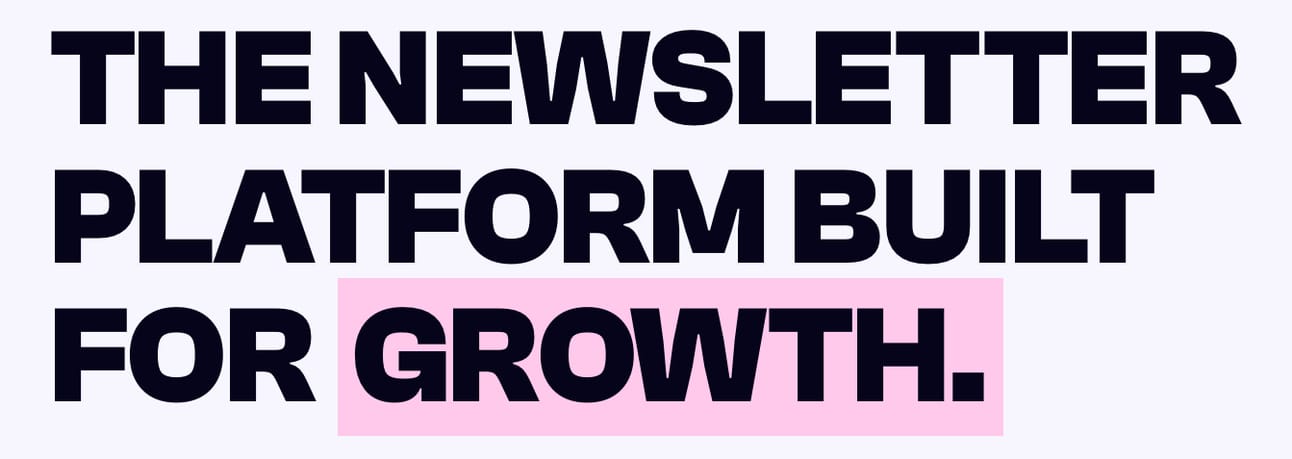Hey, Grow Newsie reader!
Have you ever opened a newsletter and immediately felt overwhelmed by a wall of text?
Your subscribers feel the same way about yours if you're not structuring your sections properly.
Today, I'm breaking down the exact framework for designing newsletter sections that people actually read (and click through).
Here's a stat that should wake you up:
Readers spend an average of 51 seconds on an email newsletter.
That's it. Less than a minute.
If your content isn't structured for quick scanning, you've already lost them. But when you design sections strategically, you can increase engagement by up to 47%.
Sponsored by: INTERCOM
Startups who switch to Intercom can save up to $12,000/year
Startups who read beehiiv can receive a 90% discount on Intercom's AI-first customer service platform, plus Fin—the #1 AI agent for customer service—free for a full year.
That's like having a full-time human support agent at no cost.
What’s included?
6 Advanced Seats
Fin Copilot for free
300 Fin Resolutions per month
Who’s eligible?
Intercom’s program is for high-growth, high-potential companies that are:
Up to series A (including A)
Currently not an Intercom customer
Up to 15 employees
1. The Hook Section (Above the Fold)
This is your opening 2-3 sentences that appear before subscribers scroll.
Best practices:
Keep it to 1-2 short paragraphs (40-60 words max)
Use conversational language that speaks directly to their pain point
Include a curiosity gap that makes them want to keep reading
Example structure:
Personal anecdote or surprising stat
→ Why it matters to them
→ What they'll learn today2. The Main Content Section
This is where your core value lives. The key? Break it into digestible chunks.
Formatting rules that work:
Use H2 or H3 subheadings every 150-200 words
Keep paragraphs to 2-3 sentences maximum
Add bullet points for lists (like this one)
Use bold text sparingly for key takeaways
Pro tip: The "inverted pyramid" approach works best—put your most valuable information first, then supporting details.
3. The Visual Break Section
Every 300-400 words, insert a visual element to give readers' eyes a rest.
Options include:
Relevant images or graphics
Pull quotes in larger text
Horizontal dividers
Data visualizations or charts
Screenshots or examples
This single change can reduce bounce rates by 23%.
4. The Action Section (CTA)
Your call-to-action deserves its own clearly defined section—not buried in a paragraph.
High-converting CTA section format:
Give it breathing room with white space above and below
Use a contrasting background color (subtle box or button)
Write action-oriented copy: "Get the template" not "Click here"
Place your primary CTA 60-70% through the newsletter
The math: Newsletters with a dedicated CTA section see 3.2x higher click-through rates than those with embedded links.
5. The PS or Quick Hits Section
This is your secret weapon—a short, scannable section at the end.
What to include:
Quick tips (3-5 bullet points)
Curated links to resources
A personal update or behind-the-scenes note
A secondary CTA or announcement
Many readers scroll to the bottom first. This section catches those skimmers and pulls them back up.
The Visual Hierarchy Checklist
Use this to audit your current newsletter structure:
✓ Font sizes create clear hierarchy: Headline (24-28px) > Subheadings (18-20px) > Body text (14-16px)
✓ White space is generous: At least 20-30px between major sections
✓ Line height is comfortable: Set body text to 1.5-1.6 line height
✓ Column width is optimal: Keep text columns to 550-600px maximum
✓ Mobile-first design: 80% of newsletters are opened on mobile—stack sections vertically
Section Layouts That Perform Best
Based on analysis of 500+ high-performing newsletters, here are the top layouts:
The Single Column (Best for storytelling): Perfect for personal newsletters and long-form content. Everything stacks vertically for easy scanning.
The 70/30 Split (Best for mixed content): Main content takes 70% width, with a sidebar for secondary items like featured links, ads, or quick tips.
The Modular Grid (Best for curated content): Organize different topics into distinct visual boxes or cards. Great for roundups and news digests.
Here's a growth hack most creators miss:
At the start of your newsletter, include a quick table of contents that teases each section:
In today's edition:
📊 Why 73% of newsletters fail (and how to avoid it)
🎯 The 5-section framework that doubled my CTR
💡 Quick wins you can implement in 10 minutesThis increases scroll-through rates by showing the full value upfront.
Common Section Design Mistakes to Avoid
❌ Too many sections: More than 6 distinct sections creates cognitive overload
❌ Inconsistent formatting: Each section should follow the same visual pattern
❌ Hidden transitions: Use clear visual separators between sections (lines, spacing, or background colors)
❌ Neglecting the Z-pattern: Readers scan in a Z-shape—place important elements along this path
❌ Cluttered sidebars: If using a two-column layout, keep the sidebar simple with maximum 2-3 elements
Your Action Plan This Week
Pick ONE newsletter section to improve:
Review your last 3 editions
Identify which section gets the least engagement
Apply one formatting technique from this guide
Test and measure the difference
Small changes compound. Improving one section at a time is more effective than redesigning everything at once.
Tools to Speed Up Section Design
Figma/Canva: Create reusable section templates
Notion: Build a section library you can copy/paste
Email builders: Use beefree.io or Unlayer for drag-and-drop sections
Remember: The best newsletter section design is the one your readers don't notice—because they're too busy reading your content.
Keep growing!
With love,
Nikhil
How was today's edition?
If you’ve ever thought about starting your own newsletter (or switching to a better platform), I’ve partnered with the beehiiv team to set you up with:
✅ 20% off your first 3 months
✅ A free 30-day trial, no credit card needed


